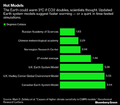File:Climate Models.png: Difference between revisions
Siterunner (talk | contribs) No edit summary |
Siterunner (talk | contribs) No edit summary |
||
| Line 1: | Line 1: | ||
<addthis /> | |||
Climate Models Are Running Hot -- and Hotter (2020) | '''Climate Models Are Running Hot -- and Hotter (2020)''' | ||
* https://finance.yahoo.com/amphtml/news/climate-models-running-red-hot-100014273.html | * https://finance.yahoo.com/amphtml/news/climate-models-running-red-hot-100014273.html (Bloomberg) | ||
Revision as of 20:54, 3 February 2020
<addthis />
Climate Models Are Running Hot -- and Hotter (2020)
There are dozens of climate models, and for decades they’ve agreed on what it would take to heat the planet by about 3° Celsius. It’s an outcome that would be disastrous—flooded cities, agricultural failures, deadly heat—but there’s been a grim steadiness in the consensus among these complicated climate simulations.
Then last year, unnoticed in plain view, some of the models started running very hot. The scientists who hone these systems used the same assumptions about greenhouse-gas emissions as before and came back with far worse outcomes. Some produced projections in excess of 5°C, a nightmare scenario....
Researchers are starting to put together answers, a task that will take months at best, and there’s not yet agreement on how to interpret the hotter results. The reason for worry is that these same models have successfully projected global warming for a half century. Their output continues to frame all major scientific, policy and private-sector climate goals and debates, including the sixth encyclopedic assessment by the UN’s Intergovernmental Panel on Climate Change due out next year. If the same amount of climate pollution will bring faster warming than previously thought, humanity would have less time to avoid the worst impacts.
For now, however, there are doubts and worries.
In the next year, climate-modeling groups will peruse each other’s results to figure out how seemingly good improvements in cloud and aerosol science may have pushed the models into hotter states. These conversations happen in the open, through peer-reviewed journals, conferences and blog posts. The authors of the main UN climate-science reports will follow along and try to stitch together a big picture, for release in 2021...
File history
Click on a date/time to view the file as it appeared at that time.
| Date/Time | Thumbnail | Dimensions | User | Comment | |
|---|---|---|---|---|---|
| current | 20:49, 3 February 2020 |  | 639 × 558 (123 KB) | Siterunner (talk | contribs) |
You cannot overwrite this file.
File usage
The following 6 pages use this file: